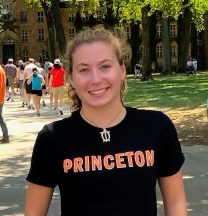Kasey Shashaty is a junior majoring in Electrical and Computer Engineering. She began working at the PULSe (Princeton University Laser Sensing) Lab in the summer of 2021 and has been working with them since. In this interview, Kasey and I discuss how she got involved in this lab through the ReMatch+ program, her experiences working in the lab both virtually and in-person, and where she is taking her experiences in the future.
A: How did you first hear about the ReMatch+ program?
K: In freshman year, I remember going to the Office of Undergraduate Research website because I wanted to get involved in research early, but I realized that the deadline had passed. So I made sure to apply in my sophomore year. I remember doing all the meet-and-greets over Zoom in the fall semester of 2020. I thought it was really cool and interesting to hear from all the grad students, even the ones that weren’t in my department, and it made me really excited about doing my own project.
A: Were there any particular standout experiences from your meet-and-greet sessions that solidified your desire to do research?
K: I didn’t actually meet up with my advisor, Prof. Gerard Wysocki, until the spring. He gave me a tour of the PULSe lab and showed me all the lasers. Before I started my research, just the concept of working with lasers was exciting to me because I didn’t really know what it entailed. In my meet-and-greets, I remember thinking that I was leaning more towards molbio and neuro-related projects at the time.
A: Can you tell me more about your experience with the matching process?
K: The process started with the meet-and-greets. Our sessions were held virtually, so I would jump from table to table, take notes, and come back to them later. I would try to talk to as many grad students as I could and write down their projects. I later went back on to the ReMatch website and the profiles of the mentors that I really liked and went through their projects in detail. I ended up emailing the electrical engineering grad student whose project I wasn’t interested in, but since he was electrical engineering, I thought he might know other people in the department that would have the same research interests as me. I made it very clear that I wanted something related to biomedical engineering. He was more than happy to connect me with his grad student friends and introduce me to the projects they were working on. So then I blasted emails to all of them and that’s how I got in touch with my grad student, Link Patrick. Since we were on campus in the spring, he invited me to the lab and showed us everything. I went on to PULSe Lab website and read all of their publications and then I came up with a proposal for airborne COVID detection, but when it got approved, the program turned virtual. So then we needed an online plan. Since our in-person plan was going to use spectroscopy, we developed a virtual project where we made online tools, so it was more programming than I had anticipated. I made a couple of web apps. The main one has a database of 500 or so interesting molecules, and when you enter parameters such as wavelength range, it will tell you what molecules from that database meet your parameters. Then the web app plots the absorption spectrum of the molecule in that range and also gives some information about it.
Stay tuned for Part 2 of this interview where Kasey talks more about her transition to in-person research!
— Agnes Robang, Engineering Correspondent


